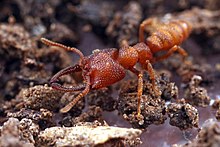
Adetomyrma is a genus of ants endemic to Madagascar. Workers of this genus are blind. The type species Adetomyrma venatrix was described in 1994, with the genus being an atypical member of its tribe, the Amblyoponini. This tribe includes the Dracula ants, members of which can feed on the hemolymph of larvae and pupae.

Adetomyrma venatrix, more commonly known as the Dracula ant, so named because of its grisly feeding habits of drinking the blood of its young, is an endangered species of ants endemic to Madagascar. Workers of this species are blind. The species was described as the type species of Adetomyrma in 1994, with the genus being an atypical member of its tribe.

Odontomachus is a genus of ants commonly called trap-jaw ants found in the tropics and subtropics throughout the world.

Amblyopone is a genus of 10 species of ants, found in Australia, New Caledonia, New Guinea and New Zealand. Ants of this genus possess the gamergate, meaning workers are able to reproduce within a colony lacking a queen.

Amblyoponinae is a subfamily of ants in the poneromorph subfamilies group containing 13 extant genera and one extinct genus. The ants in this subfamily are mostly specialized subterranean predators. Adult workers pierce the integument of their larvae and pupa to imbibe haemolymph, earning them the common name Dracula ant.

Stigmatomma is a genus of ants in the subfamily Amblyoponinae. The genus has a worldwide distribution, and like most other amblyoponines, Stigmatomma species are specialized predators. First described by Roger (1859), it was for a long time considered to be a synonym of Amblyopone until it was revived as an independent genus by Yoshimura & Fisher (2012) based on worker mandible morphology.

Xymmer is a genus of ant in the subfamily Amblyoponinae containing the single species Xymmer muticus.

Paraparatrechina is a genus of small ants in the subfamily Formicinae. The genus contains 31 species distributed in the tropics of Africa, Asia and Australia.

Adetomyrma aureocuprea is a species of ant endemic to Madagascar.

Adetomyrma cassis is a species of ant endemic to Madagascar.

Adetomyrma caudapinniger is a species of ant endemic to Madagascar.

Adetomyrma cilium is a species of ant endemic to Madagascar.

Stigmatomma pluto is a species of ant in the subfamily Amblyoponinae. The species was first described as Amblyopone pluto by Gotwald and Levieux in 1972 and moved to the genus Stigmatomma in 2012.

Adetomyrma bressleri is a species of ant belonging to the genus Adetomyrma. They are endemic to Madagascar.

Adetomyrma caputleae is a species of ant belonging to the genus Adetomyrma. They are endemic to Madagascar, where they are widespread.
Adetomyrma clarivida is a species of ant that belongs to the genus Adetomyrma. It is a blind species native to Madagascar. It was described by Yoshimura & Fisher in 2012.
Adetomyrma goblin is a species of ant that belongs to the genus Adetomyrma. They are native to Madagascar. The species was described in 2012 by Yoshimura & Fisher.
Stigmatomma groehni is an extinct species of ant in the genus Stigmatomma. It was described by Dlussky in 2009, where it was found in the Baltic Amber, alongside another extinct species Stigmatomma electrinum.














